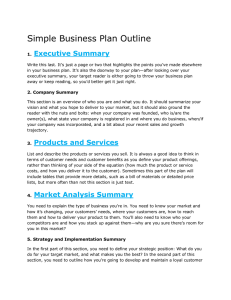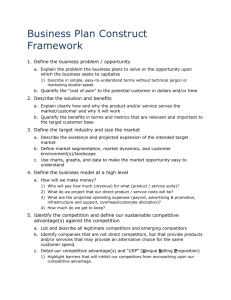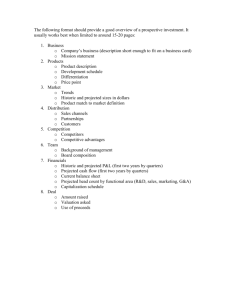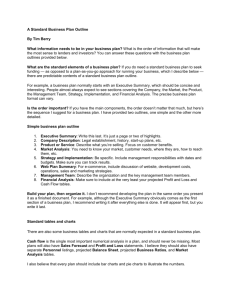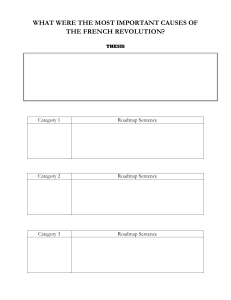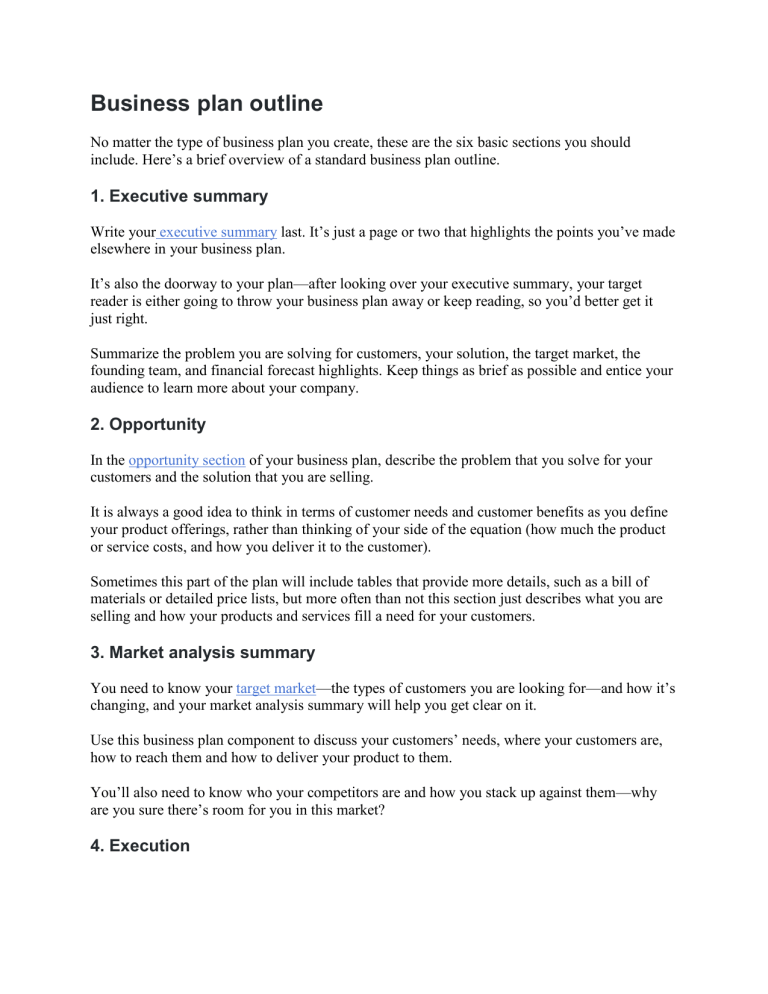
Business plan outline No matter the type of business plan you create, these are the six basic sections you should include. Here’s a brief overview of a standard business plan outline. 1. Executive summary Write your executive summary last. It’s just a page or two that highlights the points you’ve made elsewhere in your business plan. It’s also the doorway to your plan—after looking over your executive summary, your target reader is either going to throw your business plan away or keep reading, so you’d better get it just right. Summarize the problem you are solving for customers, your solution, the target market, the founding team, and financial forecast highlights. Keep things as brief as possible and entice your audience to learn more about your company. 2. Opportunity In the opportunity section of your business plan, describe the problem that you solve for your customers and the solution that you are selling. It is always a good idea to think in terms of customer needs and customer benefits as you define your product offerings, rather than thinking of your side of the equation (how much the product or service costs, and how you deliver it to the customer). Sometimes this part of the plan will include tables that provide more details, such as a bill of materials or detailed price lists, but more often than not this section just describes what you are selling and how your products and services fill a need for your customers. 3. Market analysis summary You need to know your target market—the types of customers you are looking for—and how it’s changing, and your market analysis summary will help you get clear on it. Use this business plan component to discuss your customers’ needs, where your customers are, how to reach them and how to deliver your product to them. You’ll also need to know who your competitors are and how you stack up against them—why are you sure there’s room for you in this market? 4. Execution Use this business plan section to outline your marketing plan, your sales plan, and the other logistics involved in actually running your business. You’ll want to cover the technology you plan on using, your business location and other facilities, special equipment you might need, and your roadmap for getting your business up and running. Finally, you’ll want to outline the key metrics you’ll be tracking to make sure your business is headed in the right direction. 5. Company and management summary The company and management section is an overview of who you are. It should describe the organization of your business, and the key members of the management team, but it should also ground the reader with the nuts and bolts: when your company was founded, who is/are the owner(s), what state your company is registered in and where you do business, and when/if your company was incorporated. Be sure to include summaries of your managers’ backgrounds and experience—these should act like brief resumes—and describe their functions with the company. Full-length resumes should be appended to the plan. 6. Financial plan At the very least this section should include your projected sales forecast, profit and loss, cash flow statement, and balance sheet, along with a brief description of the assumptions you’re making with your projections. You may also want to include your sales forecast, business ratios, and break-even analysis. Finally, if you are raising money or taking out loans, you should highlight the money you need to launch the business. How to write your business plan using this business plan outline Before diving into this longer outline, I want to provide you with some tips for how to use it effectively. It can be easy to get caught up in trying to replicate it exactly with your own plan, but that may not be necessary. Save yourself some time and effort by keeping the following in mind. How to organize your business plan There’s no real established order to business plans, aside from keeping the Executive Summary at the top. As long as you have all of the main business plan components, then the order should reflect your goals. If this is meant solely for your personal use, lay it out as a roadmap with similar sections grouped together for easy reference. If you’re pitching this to potential investors, lead with the stronger sections to emphasize the pitch. Or if you’re unsure of the order altogether, what’s presented in this article is the sequence of business plan elements that I suggest for a standard business plan. Should you include tables and charts in your business plan? I believe that every business plan should include bar charts and pie charts to illustrate the numbers. It’s a simple way for you, your team, and investors to visualize and digest complex financial information. Cash flow is the single most important numerical analysis in a business plan, and a standard cash flow statement or table should never be missing. Most standard business plans also include a sales forecast and income statement (also called profit and loss), and a balance sheet. I believe they should also have projected business ratios, and market analysis tables, as well as personnel listings. You may not need a full business plan Every business owner should have an ongoing planning process to help them run their business, but not every business owner needs a complete, formal business plan. If you plan to pitch or seek out funding from a potential investor, bank, or venture capital contest, then a traditional business plan will likely be necessary. So don’t include outline points just because they are on this list. Size your business plan to fit your business. Remember that your business plan should be only as big as what you need to run your business. Start with a Lean Plan Instead of jumping right into a full business plan, it may be better to start with a Lean Plan. It’s a faster and easier method that can be completed in under an hour and is simple enough to review and revise on a regular basis. And you can always take your initial Lean Plan and expand it into a traditional business plan when necessary. Lean Planning turns what could be just a static document into an active management tool for your business. This methodology is baked into LivePlan and is perfect for planning, starting, managing, and growing. Avoid these common planning mistakes Don’t make common mistakes like avoiding planning around cash flow, establishing vague goals, or projecting unrealistic growth. I’ve seen thousands of business plans, good and bad, and I can tell you that avoiding these, and other common business planning errors will put you far ahead of the curve. Keep in mind that you don’t need to be perfect when writing your plan. Just do your best to be thorough and be willing to make changes if you realize something won’t pan out like expected. Business plan outline template If you’re looking for greater insight into what goes into specific planning sections, check out the following outline. It can help you develop a detailed business plan or provide guidance as to what may be missing in your lean plan or pitch deck. Keep in mind that each business plan will look different depending on numerous factors, including the type of business and what you will be using the plan for. Consider the following outline to be a master version to reference and consider, but be sure to focus on the plan type and sections that are most beneficial to your business, pitch, or overall strategic planning. 1.0 Executive Summary 1.1 Problem A summary of the problem you are solving and an identifiable need in the market you are filling. 1.2 Solution A description of the product or service you will provide to solve the problem. 1.3 Target Market A defined customer base who will most likely purchase the product or service. For info on how to define your target market, check out our guide on the subject. 1.4 Competition The current alternatives or substitutes in the market that you and your business will be competing against. 1.5 Financial Summary Key highlights of your financial plan that covers costs, sales, and profitability. 1.6 Funding Requirements A brief outline of the amount of money you will need to start your business. Include this if you plan on pitching to investors. 1.7 Milestones and Traction A roadmap of where you currently are and specific milestones you plan to hit. 2.0 Opportunity 2.1 Problem Worth Solving A thorough description of the problem or pain point you intend to solve for your customer base. 2.2 Our Solution A thorough description of your proposed product or service that alleviates the problem of your customer base. 2.3 Validation of Problem and Solution Any data or relative information that supports your solution. If you’ve already run tests that verify your idea, this is the place to include your results. 2.4 Roadmap/Future Plans A list of steps taken so far, along with an outline of steps you plan to take in establishing or growing your business. 3.0 Market Analysis Summary 3.1 Market Segmentation Potential groups of customers separated by specific characteristics. 3.2 Target market segment strategy Your ideal customer who would most likely benefit from your business. 3.2.1 Market needs A description of how your target market is not effectively served and how your business fulfills a need. 3.2.2 Market trends How consumers in your target market tend to act including purchasing habits, financial trends, and any other relevant factors. 3.2.3 Market growth The perceived potential increase or decrease in the size of your target market. 3.3 Key customers Your ideal customer archetype who will be the main advocate for your business. 3.4 Future markets A snapshot of the potential market based on the last few sections and how your business strategy works within it. 3.5 Competition A list of potential competitors. Identifying the competition isn’t always obvious and it may take some digging on your part. 3.5.1 Competitors and alternatives A list of potential indirect competitors that provide products or services that are alternatives to your business. 3.5.2 Competitive advantage The strategic advantage(s) that makes your target market more likely to choose you over the competition. 4.0 Execution 4.1 Marketing plan An outline of your marketing and advertising strategy including costs, advertising channels, and goals. 4.2 Sales plan An estimate of the number of sales you anticipate based on market conditions, capacity, pricing strategy, and other factors. 4.3 Location and facilities Details of your physical business location (if necessary) including location and costs of operation. 4.4 Technology An explanation of any new technology that defines your business. 4.5 Equipment and tools Any required production equipment or tools and the cost associated with purchasing or renting them. 4.6 Milestones A detailed roadmap of specific goals and objectives you plan to achieve that will help you manage and steer your business. 4.7 Key metrics Performance measurements that help you gauge the overall performance and health of your business. 5.0 Company and management summary 5.1 Organizational structure An overview of the structure of your business including roles and responsibilities of specific employees and the flow of information between levels of the organization. 5.2 Management team A list of potential candidates you anticipate taking on high-level management roles within your company. 5.3 Management team gaps Any positions or areas of expertise that you currently do not have candidates ready to fill those roles. 5.4 Personnel plan A list of potential positions that you expect to require in order to run your business effectively. 5.5 Company history and ownership A summary of your company’s history and how it relates to planning your business. 6.0 Financial plan 6.1 Revenue and sales forecast Expected revenue and sales for the next 1-3 years, broken down into month-by-month increments for at least the first year. 6.2 Expenses 6.3 Projected profit and loss 6.4 Projected cash flow 6.5 Projected balance sheet 6.7 Business ratios Standard statistical indicators that showcase the current and projected health of your business. 7.0 Appendix
